Shadows over Innistrad Mechanics
Greetings, Planeswalker. Congratulations on such a successful visit to Zendikar. The tales of your travels are surely spreading throughout the Multiverse. Such heroism! It must be gratifying to have saved an entire world. I imagine you're heading to some pastoral plane for some much-needed recuperation. Wait, you're going where? Innistrad? Bleak world of horror and death? That Innistrad? Um...we should probably have a look at the mechanics from Shadows over Innistrad then, so you'll be ready. Okay, you realize those shadows aren't like rainbow shadows, right?
Double-Faced Cards
It wouldn't be Innistrad if horrible things weren't transforming into other horrible things, so double-faced cards make their return. Each double-faced card has two card faces and no back. Whoa! For the most part, they haven't changed, although we have made a few rules tweaks that may pop up. If you're comfortable with double-faced cards, feel free to skip down to the Double-Faced Cards Rules Changes section. If you're still stuck on "Whoa," let's go over what you need to know.
(Hey, quick aside. Look, I don't know if my editor is going to let this fly, but I'm already sick of typing "double-faced card." I'm just going to run with DFC. Everyone knows what I mean, right? Sweet.)
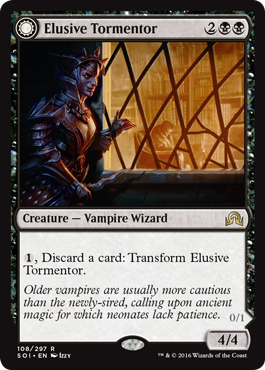

Each face has its own set of characteristics: name, types, abilities, and so on. While a DFC is on the battlefield, only the face that's up matters. If a DFC isn't on the battlefield, the front face is all that matters. You cast all DFCs using the front face. This means you cast Elusive Tormentor, paying {2}{B}{B}. You can't cast Insidious Mist or any other back face. When the spell resolves, Elusive Tormentor enters the battlefield.
The front faces of DFCs (and some back faces) each have an ability that transforms that permanent. When a DFC transforms, it turns over to its other face. A DFC that transforms never leaves the battlefield, so any counters on it stay on, any Auras or Equipment attached to it stay attached, and anything that was affecting it continues to. If it was attacking or blocking, it stays attacking or blocking. Transforming doesn't give a permanent "summoning sickness," so if a creature has been under your control continuously since the beginning of your turn, it can still attack even if it transforms—assuming it transforms into a creature! Some DFCs, like Elusive Tormentor/Insidious Mist, can transform back and forth throughout the game. For other DFCs, it's usually a one-way trip.
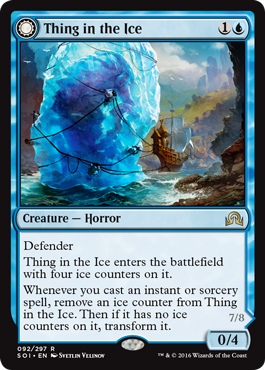
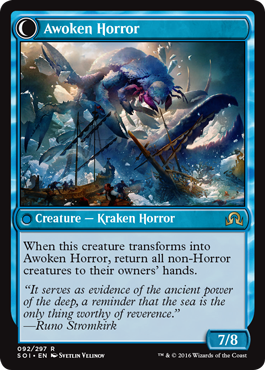
Checklist Cards
It's pretty important that all the cards in your deck are indistinguishable from one another from the back. Nowadays, most people use opaque card sleeves to accomplish this. If you're playing with DFCs and opaque card sleeves, you're good. But some people don't use sleeves, especially in Limited events. What then?
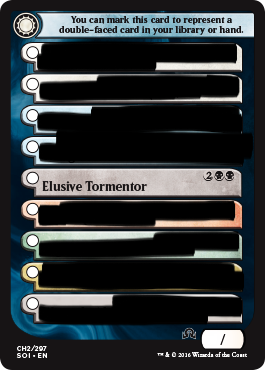
Note that most of the names aren't actually blacked out on the card, we just can't tell you what they are yet. Or don't want to. It's all the same to you.
You'll find checklist cards in some Shadows over Innistrad booster packs. There are two of them: one for commons and uncommons and another for rares and mythic rares. They act as substitutes for DFCs in your hand or library (or if they somehow get exiled face down). Before the game, just mark which DFC you're playing with and use the checklist card in the deck. You must have the real DFC with you in order to use a checklist card. Just don't mix it up with your sideboard, if you have one. On the battlefield or in the graveyard, use the actual DFC. If it gets bounced to your hand or shuffled into your library, swap the checklist card back in. You must use checklist cards, opaque sleeves, or both.
Double-Faced Cards Rules Changes
We tweaked three things about DFCs this time around to smooth out some edge cases. Oh, did you skip to this section from the top? Yeah, we say "DFCs" now. We cool like that. This part gets a bit technical, but we'll be back in "Happy Mechanic Preview Land" soon, I swear.
1. Converted mana cost
Remember when I said that the characteristics of the face that's up are all that matter? That wasn't quite accurate. Under the new rules, the converted mana cost of the back face of a DFC is based on the mana cost of the front face. (Previously, because the back faces lacked mana costs, their converted mana costs were all 0.) The one exception is if something is a copy of the back face of a DFC, its converted mana cost is 0. So If I control Insidious Mist, it has no mana cost, but its converted mana cost is 4. If I then put a copy of Insidious Mist onto the battlefield, that copy's converted mana cost is 0.
2. Entering the battlefield transformed
A few effects can put a card onto the battlefield transformed. This means to put it on the battlefield with its back face up. Starting with this set, we have a new rule that if you're told to put a card that isn't a DFC onto the battlefield transformed, it just stays where it is. This may affect a few cards in this set, but I think the Magic Origins planeswalkers illustrate the change nicely. (This is code for "The cool cards in this set I could use to illustrate this haven't been previewed yet." I know. I feel the same way.) Say you control a Clone that's copying Jace, Vryn's Prodigy, and you activate faux-Jace's ability with four thousand cards in your graveyard. Well, four thousand is "five or more," so faux-Jace dutifully exiles himself. Then he tries to return transformed, but in exile he's just a single-faced Clone. He's not a DFC, so he gets detained at the border and remains in exile. I hope the card you drew was good, because this wasn't a great play otherwise.
3. No flippy-floppy
I've saved our most technical change for last. Here's the new rule: if a DFC has an activated or triggered ability that transforms it, that permanent transforms only if it hasn't since that ability was put on the stack. What does that mean? For example, say you activate Elusive Tormentor's ability, then you activate it again in response. Why? Because you want to discard a lot of cards. Why? We're almost there. Relax. The first ability to resolve will cause Elusive Tormentor to transform, as expected. But the second ability won't, as Elusive Tormentor has already transformed because of the first ability.
Delirium
As advertised, Innistrad is a bleak world of horror and death, so a focus on the graveyard is to be expected. Delirium is a new ability word that highlights cards that get better if you have four or more card types represented in your graveyard. There are many different kinds of delirium abilities, including activated abilities such as the one found on Reaper of Flight Moonsilver.
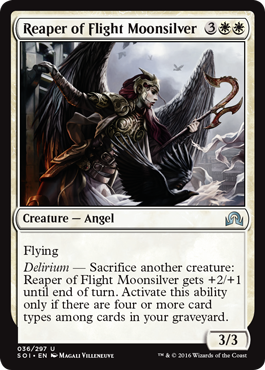
The card types that could show up in your graveyard are artifact, creature, enchantment, instant, land, planeswalker, sorcery, and tribal (a card type found on older cards). Don't count supertypes like basic or legendary, and don't count subtypes like Vampire or Equipment. The number of cards doesn't matter, as long as you get four or more card types. An artifact creature, an instant, and a planeswalker will do the trick.
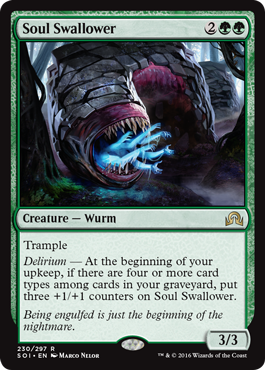
As to how you get all these card types in your graveyard, there's the traditional route: have some creatures die in combat, cast a few spells, maybe a planeswalker will decide she's had enough of your shenanigans and sit in your graveyard for a while because her loyalty...look, not every metaphor works, okay? We've also helpfully supplied some other ways to get cards into your graveyard, such as Warped Landscape.
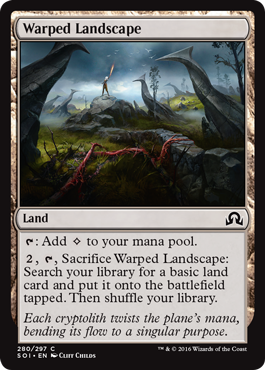
Some instants and sorceries have additional effects if you have four or more card types in your graveyard. Others use "instead" to denote an upgraded effect. Remember that the resolving instant or sorcery doesn't count. It's on the stack as you follow its instructions, not in your graveyard.
Investigate and Clues
Mysteries permeate Innistrad like strange references permeate my writing. Zoinks! To solve these mysteries, you'll need to investigate and follow the Clues.
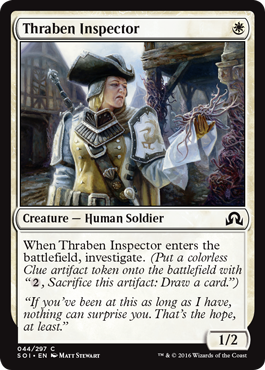
She looks friendly enough. I'm sure she'll help! Investigate is a new keyword action found in Shadows over Innistrad. It's pretty straightforward. To investigate, you put a Clue token onto the battlefield. A Clue is a new artifact type. Clues are colorless artifacts (what, you though they'd be blue?), and they each have the ability "{2}, Sacrifice this artifact: Draw a card."
The Inspector does a bit of investigating, but she goes on her first coffee break pretty early. Perhaps a classic tool of examination will prove a more reliable source of information.
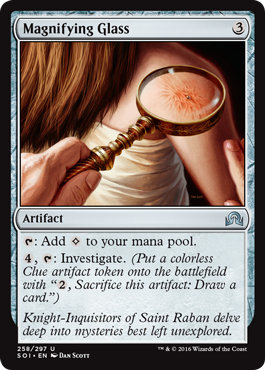
Most of the time, you'll sacrifice Clues to draw cards—but they are artifacts, so I'm sure you'll find other uses for them as well.
Madness
The next stop on our tour of brand new, never-before-seen Shadows over Innistrad abilities is madness, a returning ability you may have seen before. If you discard a card with madness, you exile it instead of putting it into your graveyard. This causes an ability to trigger. When that ability resolves, you can cast the spell for its madness cost. If you don't cast the spell this way, it's put into your graveyard. Well, all of that just sounds insane.
Note that the mandatory discard into exile is a small change from previous rules. Before, you could discard a card with madness into your graveyard and skip the whole madness thing. This may be relevant with cards like Jace, Vryn's Prodigy. That dude shows up a lot in this article for a card not in this set.
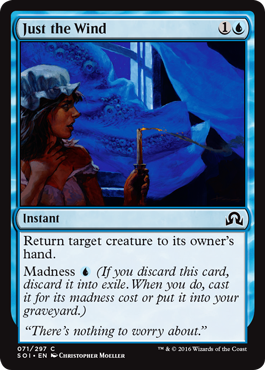
One cool thing about casting a spell using the madness ability is it doesn't matter what its card types are. So if you manage to discard a creature card with madness during an opponent's turn, you can cast that spell and maybe create a surprise blocker. The spell's mana cost and converted mana cost don't change. You're just paying the madness cost instead.
It doesn't matter why you're discarding a card with madness. It could be to pay the activation cost for an ability like Elusive Tormentor's. Maybe it's because your opponent has forced you to with their own spell. Heck, maybe the turn's ending and you've got more than seven cards in hand, you rascal. Whatever the reason, you'll have the chance to cast the card by paying its madness cost. Just remember that you can't just discard a card because you want to. Something has to be telling you to. And not just the wind.

Oh, yeah. That's fine. It can tell you to. No problem here. Moving on...
Skulk
By now, I'm sure you've noticed that Innistrad is a bleak world of...Right, we've been over this. For some creatures, being all conspicuous isn't the best plan. For those creatures, we present a new keyword: skulk. A creature with skulk can't be blocked by any creature with greater power. Introducing Farbog Revenant.
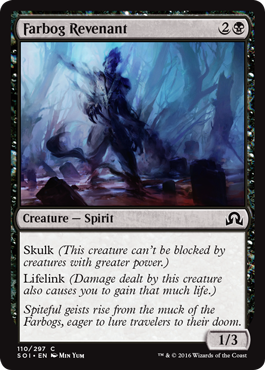
Aww...it's totes adorbs, in an inky kind of way. With skulk, you consider the power of potential blockers only as blocks are being declared. If Farbog Revenant gets legally blocked by a 1-power creature, raising the power of the blocker won't undo the block. But if your opponent has amassed beefy defenses, skulk can be an effective way to sneak damage in.
Happy Hunting!
And that's it. I hope this look at Shadows over Innistrad will prepare you for your Prerelease and beyond. In addition to the new and returning mechanics, there are many great individual cards to keep a Planeswalker such as yourself on your toes. Or fins. Protuberances? Whatever you got. I don't judge.

